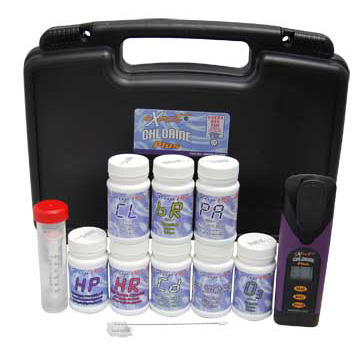Sniff test: If you smell chlorine, then your water most likely contains some amount of chlorine. To determine the exact amount, however, you will need to use other testing methods.
As a general rule, if your water has a chlorine smell to it, then you most likely have, at the very least, chloramines (combined chlorine) present. This does not, however, rule out the possibility that your water also may contain a free chlorine residual, too.
For the record, health officials and scientists agree that chlorine gas does NOT do the body any favors and in too great a quantity can cause lung and eye irritation… so we suggest not performing the ‘sniff test’ if you can help it.
Taste test: Not all water that contains chlorine will smell like a swimming pool. While combined chlorine (chloramines) has a strong odor associated with it, free chlorine does not. Therefore water that may not stink like chlorine may still possess a strong chlorine taste.
We do NOT advocate the taste test method for any reason. We mentioned it just so that we could talk about why water can lack a strong chlorine smell and yet still have a strong chlorine taste.
Chemical test kit: We know of many different test kits that the general public can use to determine the free and/or total chlorine concentrations in their drinking water.
“Wait… Did you just talk about two different types of chlorine?”
Yes, because as we discussed during a few moments ago, one can have free chlorine and/or combined chlorine in their water. Typically free chlorine acts as the main sanitizing and/or disinfecting agent in a chlorinated water supply and once the free chlorine finds an organic contaminant to ‘kill’, it becomes entangled with the contaminant and forms a combined chlorine molecule.
Therefore, it stands to reason that a chlorinated water supply may contain both free and combined chlorine at the same time if the free chlorine molecules have successfully neutralized all biological contaminants and the effort did not require the use/exhaustion of all free chlorine molecules present in the water supply.
Getting back to chemical test kits, please…
Now that we have established the existence of different types of chlorine which may or may not exist in a water supply, we will now discuss different ways of testing for chlorine in a water supply.
- Test Strips — Perfect for field testing because they require the user only to dip the strip into the water and compare the color of the test pad/area to a color chart that came with the package of test strips. Products exist for the detection of both free and total chlorine. People can even get a single test strip to test for both at the same using a product called WaterWorks 2
- ‘Wet’ Chemical Test Kits — Considered by most as the traditional, tried and true method for testing the quality of water. Most ‘wet’ kits typically require dissolving DPD as a tablet, powder or liquid into water samples and either comparing the colors of resultant solutions to color charts or adding drops of an additional chemical until a second color change reaction occurs.
Simpler ‘wet chemistry’ test kits for chlorine (i.e. 2-way pool water test kits) use a different chemical called OTO (Orthotolidine) and detect total chlorine (free chlorine + combined chlorine = total chlorine).
Problem w/ using OTO: No way exists to use OTO in a way that will allow a person to determine the free chlorine concentration.
The DPD reagent system does, however, allow for differentiation between the two if a water sample has DPD-1 added first, gets analyzed, and then has DPD-3 added… and then get analyzed again.
- Water Testing Meters — Most water testing meters for chlorine (i.e. the eXact Chlorine Photometer) require the use of DPD, a chemical indicator which turns a shade of pink/red in the presence of chlorine molecules. DPD-1 indicates the presence of free chlorine and a combination of DPD-1 plus DPD-3 indicates the presence of free and/or combined chlorine (total chlorine).
So… Which method of chlorine testing will work best for you? Ask yourself the following questions:
1) Do you need to test for free chlorine, total chlorine or both?
2) How much accuracy and precision will you need in your results?
3) If performing testing for reporting purposes, what do the rules and regulations governing your profession say you must use as a testing methods?
Once you have answered those three questions you will have a clear idea of whether you should use chlorine test strips, wet chemistry test kits for chlorine testing or chlorine testing meters to determine chlorine concentrations in your water.






















